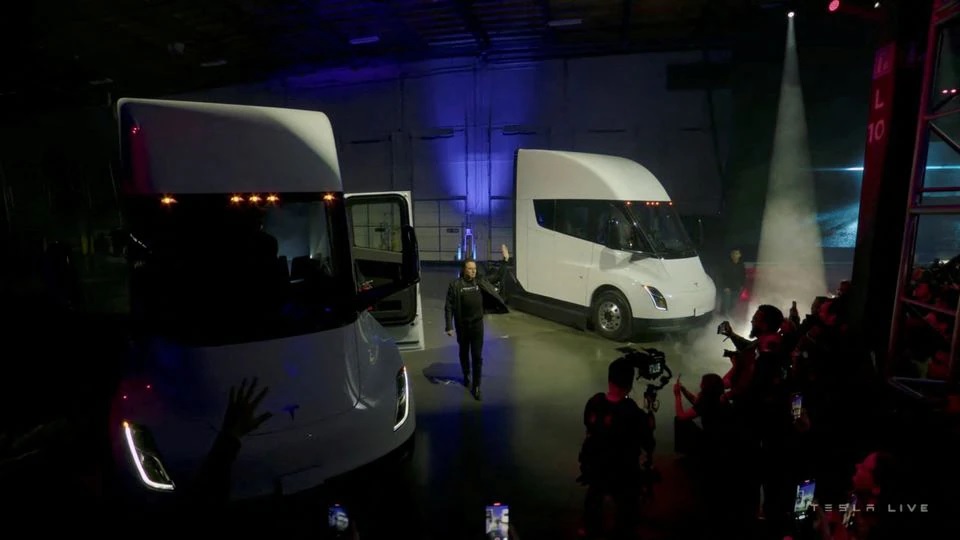- Tesla ships first Semi to PepsiCo five years after unveiling it
- No details on orders or capacity for electric truck
- Semi uses existing Tesla motors, to feature new Supercharger
Dec 1 (Reuters) – Tesla Inc (TSLA.O) Chief Executive Elon Musk delivered the company’s first heavy-duty Semi on Thursday to PepsiCo (PEP.O) without offering updated forecasts for the truck’s pricing, production plans or how much cargo it could haul.
Musk, who appeared onstage at an event at Tesla’s Nevada plant, said the battery-powered, long-haul truck would reduce highway emissions, outperform existing diesel models on power and safety and spin-off a fast-charging technology Tesla would use in its upcoming Cybertruck pickup.
“If you’re a trucker and you want the most badass rig on the road, this is it,” Musk said, noting that it was five years since Tesla had announced it was developing the all-electric truck. Still, industry experts remain skeptical that battery electric trucks can take the strain of hauling hefty loads for hundreds of miles economically.
At Musk’s first Tesla reveal since taking over Twitter – an acquisition some investors worry has become a distraction – the company did not announce pricing for the Semi, provide details on variants of the truck it had initially projected or supply a forecast for deliveries to PepsiCo or other customers. Tesla said it would begin using the Semi to ship parts to its plant in Fremont, California.
In 2017, Tesla had said the 300-mile range version of the Semi would cost $150,000, and the 500-mile version $180,000, but Tesla’s passenger electric vehicle prices have increased sharply since then.
Robyn Denholm, chair of Tesla, recently said the automaker might produce 100 Semis this year. Musk has said Tesla would aim to produce 50,000 of the trucks in 2024.
PepsiCo, which completed its first cargo run with the Tesla truck to deliver snacks for those attending the Nevada launch event, had ordered 100 trucks in 2017.
Brewer Anheuser-Busch (ABI.BR), United Parcel Service Inc (UPS.N) and Walmart Inc (WMT.N) were among other companies that had reserved the Semi. Tesla did not provide details on orders or deliveries to customers, nor an estimate on what the total cost of ownership for future buyers would be compared to diesel alternatives.
‘NOT IMPRESSIVE’
Musk said the Semi has been doing test runs between Tesla’s Sparks, Nevada factory and its plant in Fremont, California. Tesla said it had completed a 500-mile drive on a single charge, with the Semi and cargo weighing in at 81,000 pounds in total.
Tesla did not disclose the weight of an unloaded Semi, one key specification analysts had hoped to learn and an important consideration for the efficiency of electric trucks.
Musk has spoken in the past about the prospect of fully autonomous trucks. Tesla did not provide details on how Tesla’s driver assistance systems would function in the Semi it unveiled on Thursday or future versions.
The Semi delivery presentation ended without Musk taking questions, as he often does at Tesla events.
“Not very impressive – moving a cargo of chips (average weight per pack 52 grams) cannot in any way be said to be definitive proof of concept,” said Oliver Dixon, senior analyst at consultancy Guidehouse.
Tesla had initially set a production target for 2019 for the Semi, which was first unveiled in 2017. In the years since, rivals have begun to sell battery-powered trucks of their own.
Daimler’s (MBGn.DE) Freightliner, Volvo (VOLVb.ST), startup Nikola (NKLA.O) and Renault (RENA.PA) are among Tesla’s competitors in developing alternatives to combustion-engine trucks.
Walmart (WMT.N), for instance, has said it has been testing Freightliner’s eCascadia and Nikola’s Tre BEV trucks in California.
‘LIKE A CHEETAH’
The Semi is capable of charging at 1 megawatt and has liquid-cooling technology in the charging cable in an updated version of Tesla’s Supercharger that will be made available to the Cybertruck, Musk said. The Cybertruck is scheduled to go into production in 2023.
Trucks in Semi’s category represent just 1% of U.S. vehicle sales but 20% of overall vehicle emissions, Tesla said.
Tesla said other, future vehicles would use powertrain technology developed for the Semi without providing details. The Semi uses three electric motors developed for Tesla’s performance version of its Model S, with only one of them engaged at highway speed and two in reserve for when the truck needs to accelerate, a feature that makes the truck more energy-efficient, Musk said.
“This thing has crazy power relative to a diesel truck,” Musk said. “Basically it’s like an elephant moving like a cheetah.”
In a slide displayed as part of Musk’s presentation, Tesla showed an image of a future “robotaxi” in development with a mock-up of the future car covered under a tarp.
The presentation took place after Tesla shares closed at $194.70. The stock has fallen about 45% so far this year, losing about $500 billion in market capitalisation, down to about $615 billion.
Among factors cited by investors have been Musk’s sales of Tesla shares to finance his takeover of Twitter, signs that a slowing global economy has started to cut into demand for Tesla’s premium-priced cars, and a warning by the company that it might not meet its target to grow deliveries by 50% this year.










